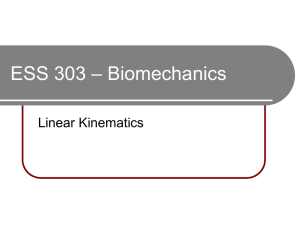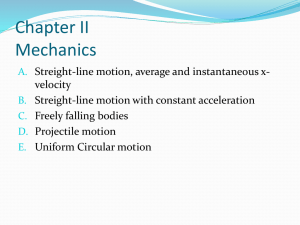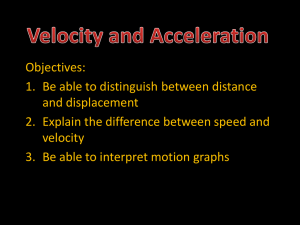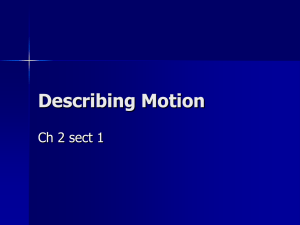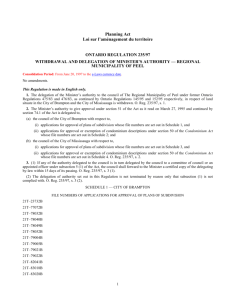AP Physics C - Methods of Motion
advertisement
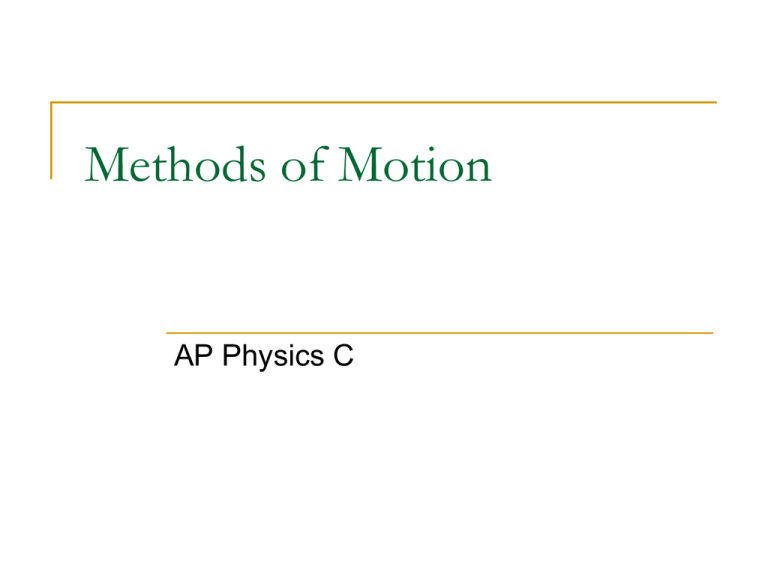
Methods of Motion AP Physics C Displacement Displacement (x or y) "Change in position" It is not necessarily the total distance traveled. In fact, displacement and distance are entirely different concepts. Displacement is relative to an axis. o o o o o "x" displacement means you are moving horizontally either right or left. "y" displacement means you are moving vertically either up or down. The word change is expressed using the Greek letter DELTA ( Δ ). To find the change you ALWAYS subtract your FINAL - INITIAL position It is therefore expressed as either Δx = xf - xi or Δy = yf - yi Distance - How far you travel regardless of direction. Example Suppose a person moves in a straight line from the lockers( at a position x = 1.0 m) toward the physics lab(at a position x = 9.0 m) , as shown below The answer is positive so the person must have been traveling horizontally to the right. Example Suppose the person turns around! The answer is negative so the person must have been traveling horizontally to the left What is the DISPLACEMENT for the entire trip? x x final xinitial 1.0 1.0 0m What is the total DISTANCE for the entire trip? 8 8 16 m Average Velocity Velocity is defined as: “The RATE at which DISPLACEMENT changes”. Rate = ANY quantity divided by TIME. Average SPEED is simply the “RATE at which DISTANCE changes”. d s t Example A quarterback throws a pass to a defender on the other team who intercepts the football. Assume the defender had to run 50 m away from the quarterback to catch the ball, then 15 m towards the quarterback before he is tackled. The entire play took 8 seconds. Let's look at the defender's average velocity: x 35m 0m v 4.38 m / s t 8s 0 s Let's look at the defender's speed: s d 65m 8.125 m / s t 8s “m/s” is the derived unit for both speed and velocity. Instantaneous Velocity Instantaneous velocity is a measure of an object’s displacement per unit time at a particular point in time. Example: A body’s position is defined as: 4ˆ ˆ d (7t i j ) dx t v dt dt v lim t 0 x t dx v dt x(t ) 7t 3iˆ 4ˆ j , v(t ) ? t 3 4 ˆ ˆ v(t ) [21t i 2 j ] m / s t 2 Average Acceleration Acceleration is the RATE at which VELOCITY changes. A truck accelerates from 10 m/s to 30 m/s in 2.0 seconds. What is the acceleration? v 30 m / s 10 m / s 20 m / s a 10 m / s / s or m / s 2 t 2s 0s 2s Suppose the same truck then slows down to 5 m/s in 4 seconds. What is the acceleration? v 5m / s 30 m / s 25m / s a 12.5 m / s / s or m / s 2 t 4s 0s 2s “m/s/s” or “m/s2” is the derived unit for acceleration. What do the “signs”( + or -) mean? Quantity Positive Negative Displacement You are traveling north, east, right, or in the +x or +y direction. You are traveling south, west, left, or in the –x or –y direction. Velocity The rate you are traveling north, east, right, or in the +x or +y direction. The rate you are traveling south, west, left, or in the –x or –y direction. Acceleration Your velocity(speed) is increasing in a positive direction or your speed is decreasing in a negative direction. Your velocity(speed) is decreasing in a positive direction or your speed is increasing in a negative direction. Beware – the signs can confuse! Suppose a ball is thrown straight upwards at 40 m/s. It takes 4 seconds to reach its maximum height, then another 4 seconds back down to the point where it was thrown. Assume it is caught with the same speed it was thrown. Calculate the acceleration upwards and downwards. Upwards v 0m / s 40m / s 40m / s a 10m / s t 4s 0s 4s Downwards v 40m / s 0m / s 40m / s a 10m / s t 4s 0s 4s This negative sign came from using the DELTA This negative sign came from the DIRECTION of the velocity. It is no surprise you get a negative answer both ways as gravity acts DOWNWARDS no matter if the ball goes up or down. It is GRAVITY which changes the ball’s velocity. Instantaneous Acceleration Instantaneous velocity is a measure of an object’s velocity per unit time at a particular point in time. If the velocity of an object is defined as: v(t ) [21t 2iˆ dv a dt 4 ˆ j ] m / s, a(t ) ? 2 t 4 ˆ ˆ d (21t i 2 j ) dv t a dt dt 2 a lim t 0 v t 8 [ 42tiˆ 3 ˆj ] m / s / s t

